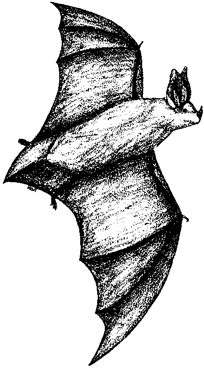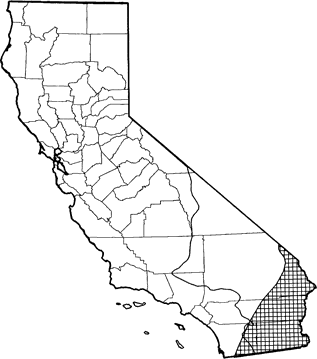
California Leaf-nosed Bat
Distribution, Abundance, and Seasonality
The California leaf-nosed bat is found from Riverside, Imperial, San Diego, and San Bernardino cos south to the Mexican border. Former populations have disappeared from coastal basins, from Los Angeles to San Diego. Desert populations have declined, but this species is fairly common in some areas along the Colorado River. Habitats occupied include desert riparian, desert wash, desert scrub, desert succulent shrub, alkali desert scrub, and palm oasis. California records are below 600 m (2000 ft); elsewhere the species ranges to 1300 m (4200 ft).

Range Map
Specific Habitat Requirements
Feeding: Feeds on a variety of flying and flightless insects, including orthopterans, sphingid and noctuid moths, beetles, and cicadas. Elsewhere in its range, it is partly frugivorous. Forages close to the ground (often less than 1 m), flying slowly and silently. This agile, maneuverable flier gleans from foliage and captures prey on the ground and in the air, utilizing vision and echolocation. Capable of hovering and avoiding obstacles. Large prey may be carried to the roost for consumption. Although incapable of walking, this species can take off from a flat surface.
Cover: Day roosts usually are in deep mine tunnels or caves, occasionally in buildings or bridges. The roost must provide shelter from heat and aridity. Temperature in one roost was 29ÁC (84ÁF), while outside temperature was 43Á C (110Á F) (Vaughan 1959), and relative humidities always are greater than 50%. Preferred roosts have high ceilings and sufficient space for flight. Usually, these bats may be found hanging by their feet 10-25 m (30-80 ft) from the entrance, depending on temperature. Night roosts may be in buildings, mines, bridges, rock shelters, or other sites with overhead protection. These bats often are found in large groups, and have a high tolerance to ammonia (Mitchell 1963).
Reproduction: Females form maternity colonies in summer, preferring tunnels and caves. Males form smaller groups, which occupy typical day and night roosts.
Water: California leaf-nosed bats have been kept 6 wk in captivity without drinking. Renal morphology indicates that this species can produce concentrated urine (Lu and Bleier 1981).
Pattern: Roosts in rocky, rugged terrain with mines and caves. Forages over nearby flats and washes.
Species Life History
Activity Patterns: Nocturnal; active yearlong. This species emerges late, usually 1-2 hr after sunset in summer, and at sunset in winter. Emergence is variable; groups may emerge from a roost over several hours. A second peak of activity occurs at about 10 pm. Bats return to the day roost by about 1 hr before sunrise. Leaf-nosed bats do not hibernate. They move within the roost to find suitable temperatures, and undergo brief periods of reduced body temperature.
Seasonal Movements / Migration: Some individuals are yearlong residents in California. Individuals occupy different roosts in summer and winter. Probably some individuals migrate to Mexico in winter.
Home Range: Forages up to 1.3 km (1 mi) from roost. Most activity probably closer to roost (Vaughan 1959).
Territory: Gregarious. Groups of up to 500 have been observed in California. Both sexes may roost together in the non-breeding season, but roost separately during spring and summer.
Reproduction: Copulation occurs from September to November. Delayed implantation is followed by births from May to June. The single litter has 1 young. Twins are rare. The precocial young suckle for 1 mo. Females breed in first autumn, males in second yr. The maximum recorded longevity is 10.4 years (Cockrum 1973).
Niche: A maneuverable, low-flying forager that gleans and feeds on the ground and in the air.
Comments: Sensitive to roost disturbance. No longer occurs in coastal regions, and most records currently are from mountain ranges bordering the Colorado River. A California Species of Special Concern (Williams 1986).
Sources & References
California Department of Fish and Game, 1999.
California's Wildlife, Sacramento, CA.
Written by: J. Harris, reviewed by: P. Brown, edited by: D. Alley, R. Duke
Anderson, S. 1969. Macrotus waterhousii. Mammal. Species No. 1. 4pp. Arnold, L. W. 1943. California winter records of Macrotus californicus Baird. J. Mammal. 24:103. Banks, R. C. 1965. The bats of Anza-Borrego Desert State Park, San Diego County, Calif. Rept. to Calif. Div. Beaches and Parks. 30pp. Barbour, R. W., and W. H. Davis. 1969. Bats of America. Univ. of Kentucky Press, Lexington. 286pp. Barlow, J. C., and J. R. Tamsitt. 1968. Twinning in American leaf-nosed bats (Chiroptera: Phyllostomatidae). Can. J. Zool. 46:290-292. Bradshaw, G. van R. 1961. A life history of the California leaf-nosed bat, Macrotus californicus. Ph.D. Thesis, Univ. Arizona, Tucson. Diss. Abstr. 22:679-680. Bradshaw, G. van R. 1962. Reproductive cycle of the California leaf-nosed bat, Macrotus californicus. Science 136:645-646. Cockrum, E. L. 1973. Additional longevity records for American bats. J. Ariz. Acad. Sci. 8:108-110. Constantine, D. G. 1961. Locality records and notes on western bats. J. Mammal. 42:404-405. Davis, R., and E. L. Cockrum. 1963. Bridges utilized as day roosts by bats. J. Mammal. 44:428-430. Davis, R., and E. L. Cockrum. 1964. Experimentally determined weight lifting capacity in individuals of five species of western bats. J. Mammal. 45:643-644. Grinnell, H. W. 1918. A synopsis of the bats of California. Univ. Calif. Publ Zool. 17:223-404. Grummon, R. A., and A. Novick. 1963. Obstacle avoidance in the bat, Macrotus mexicanus. Physiol. Zool. 36:361-369. Hatfield, D. M. 1937. Notes on the behavior of the California leaf-nosed bat. J. Mammal. 18:96-97. Hayward, B., and R. Davis. 1964. Flight speeds in western bats. J. Mammal. 45:236-242. Huey, L. M. 1925. Food of the California leaf-nosed bat. J. Mammal. 6:196-197. Lu, S. L., and W. J. Bleier. 1981. Renal morphology of Macrotus (Chiroptera, Phyllostomidae). J. Mammal. 62:181-182. Mitchell, H. A. 1963. Ammonia tolerance of the California leaf-nosed bat. J. Mammal. 44:543-551. Stager, K. E. 1943. California leaf-nosed bat trapped by desert shrub. J. Mammal. 24:396. Stephens, F. 1906. California mammals. West Coast Publ. Co., San Diego, Calif. 351pp. Vaughan, T. A. 1959. Functional morphology of three bats: Eumops, Myotis, Macrotus. Univ. Kans., Mus. Nat. Hist. Publ. 12:1-153. Williams, D. F. 1986. Mammalian species of special concern in California. Calif. Dept. Fish and Game, Sacramento. Admin. Rep. 86-1. 112pp.
California Animal Facts | California's Wildlife